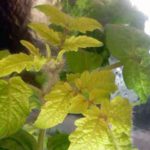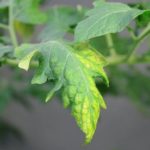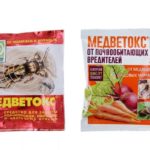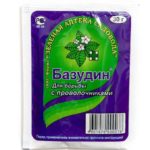Often, even experienced farmers face the problem of yellowing of tomato leaves in greenhouses. Why tomatoes can turn yellow in the greenhouse and what to do about it, we will tell in this article.
The reason for the yellowing of leaves may be:
- Late transplant of seedlings;
- Damage to the root system during transplantation;
- Improper organization of irrigation;
- Non-compliance with the temperature regime;
- Heavy soil;
- Lack of nutrients in the soil;
- Diseases and pests.
Consider each of the reasons separately.
Table of contents
Untimely planting of tomato seedlings in the greenhouse
Growing seedlings at home, you must remember about the timing of transplantation. Start planting seedlings in greenhouses or polycarbonate greenhouse at the age of 55—60 days. In overgrown seedlings, the root system gathers into a lump due to the lack of space in the tanks and begins to die.

In this case, you must perform root irrigation. Preparing the solution:
- water - 10 liters;
- fertilizers - 100 gr.
This solution irrigates the root system. Seedlings will continue to develop well, but there will be a delay in the development of the bush for several weeks.
Damage to the root system during transplanting tomato
Mechanical damage to the roots can occur as a result of inaccurate planting of seedlings, or careless loosening of the soil. In this case, the lower part of the seedling and the leaves may turn yellow.
When the root grows, the plant will soon return to normal. You can help the plant to recover by irrigating with the drug "Cornevin"And spraying the leaves complex feeding.
Wrong watering tomatoes
Tomatoes are a crop that easily tolerates drought. Despite the fact that the root system of plants is quite powerful and goes deep, the bulk of the roots that absorb moisture, is close to the soil surface. Therefore, irregular watering adversely affects the plant.
Just tomatoes do not like an overabundance of moisture. Watering should be carried out rarely, but plentifully. In greenhouses, moisture evaporates much more slowly than in open beds, so an overabundance of moisture can lead to fungal diseases.

Watering must be done under the root. Water that falls on the leaves, causing them to yellow.
Failure of temperature
If in a greenhouse there are sudden changes in temperature during the day and at night, this will have a negative effect on the seedlings. If the leaves turn yellow and dry - this talks about overheating saplings. When supercooling leaves turn yellow, lose elasticity and fade. This indicates poor root performance.
It is possible to prevent temperature changes in a greenhouse with water barrels. In the daytime, the water heats up, absorbing heat, at night it gives up.
Heavy acidic soil
Tomatoes do not tolerate heavy soil and high acidity. The soil for tomatoes is better to prepare yourself before planting.
It is necessary to mix in equal parts of the garden land, peat and sifted river sand and add ash to normalize the level of acidity. Soil needed loosen after each wateringto prevent soil stagnation leading to acidification of the soil.

When loosening, additional oxygen is supplied to the roots, which ensures normal plant growth.The absence of these measures leads to yellowing.
Soil deficiency of trace elements
For tomatoes, it is very important to have enough minerals in the soil. Their lack leads to yellowing of the leaves.
Signs of micronutrient deficiencies:
- Nitrogen deficiency. With a shortage of nitrogen in the soil, the plant will be weak, with a thinned stem, small foliage. The first to begin to turn yellow lower leaves and streaks become bluish in color. It is possible to eliminate this disadvantage by watering with a solution of mullein: for 10 liters of water, 1 liter of fermented mullein and 200 grams of ash.
- Magnesium deficiency. The leaves are covered with brown-brown spots and fall. Eliminate can be fertilized with magnesium nitrate.
- Potassium deficiency. The leaf is covered with yellow spots and curls. Until the fruit is set, it is necessary to feed on the basis of potassium chloride, then potassium phosphate can be used.
- Lack of sulfur. The leaves are covered with brown-brown spots and fall. In the process of fruiting twice to make top-dressings with high sulfur content.
- Boron deficiency. Yellowing leaf at the top of the bush. Introduce feeding based on boric acid.
- Manganese fasting. The leaves have a light yellow color. Young leaves are struck first, and then old ones.
- Yellow with nitrogen deficiency
- Tomato leaves with a lack of potassium
In the latter case, it is necessary to put in the soil fermented mullevel solutiondivorced in the ratio:
- mullein - 1 liter
- water - 20 liters
It is also recommended to spray tomato bushes. manganese solution in relation to:
- warm water - 10 liters
- manganese— 1 tablespoon
Diseases and pests
Yellow foliage can occur as a result of the appearance in the soil of such pests as:
- Medvedka;
- wireworm;
- nematodes;
- tobacco aphid.
- Medvetoks
- Basudin
The wireworm, nematode, and medvedka feed on the root system of plants, damaging it. Each of these pests are fought by different means.
Against Medvedka recommended to use the drug "Medvetoks". To combat wireworm use "Basudin". If nematodes are found in the greenhouse, it is recommended to fully replace soil. With this type of pests fight extremely difficult.
These diseases include:
- late blight;
- fusarium
Late blight
With this disease, brown spots appear on the leaves, which later also affect the fruit. The cause of this disease is improper watering.
It must be remembered that watering should be carried out at the root, not falling on the leaves. In case of late blight, the bushes must be processed. bordeaux mixture.
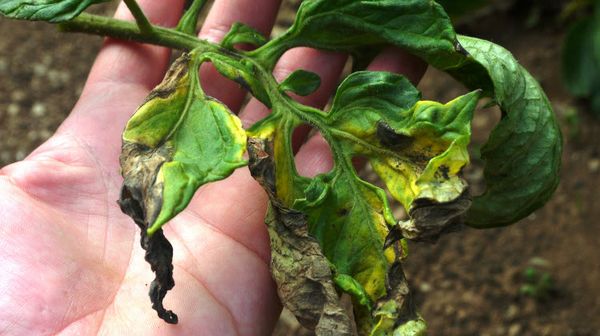
At home it can be made independently. When preparing this solution, it is necessary to strictly observe the proportions. To obtain a 1% solution of the components diluted in the following ratio:
- water - 10 liters;
- copper sulphate - 100 grams;
- quicklime — 150 grams.
For spraying tomatoes on 1 square. meter will need 2 liters of solution.
Fusarium
With this disease, the leaves of tomatoes lose their elasticity and change color. The cause of this disease are:
- infected instrument;
- infected seeds.
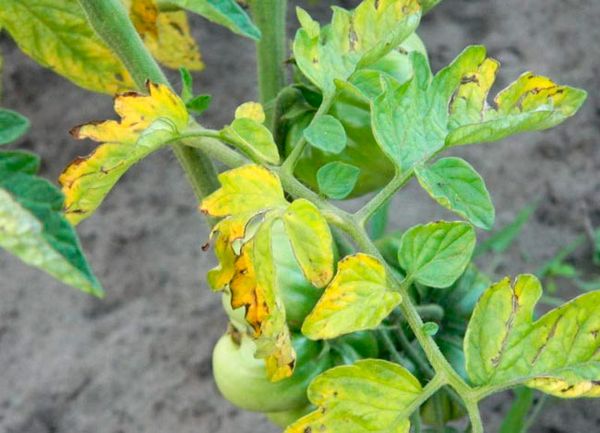
This disease can manifest itself in both an adult plant and a seedling. You can get rid of this problem with the help of drugs "Previkur Energy"And"Trichodermin».
The reasons why the leaves turn yellow, prevention and elimination
- Shortage of microelements. With this problem, regular feeding is necessary.
- Pest damage. Regular destruction of weeds, disinsection of soil, strengthening of plant immunity, normalization of the microclimate in the greenhouse will help to avoid this problem.
- Diseases. To prevent diseases, it is necessary to timely disinfect the greenhouse, seeds, soil. Prevent thickening of the plants, as well as regularly air the greenhouse.
- Root damage. This problem can be avoided by growing seedlings in separate containers. Replant with a lump of land from the previous place of growth. Carefully loosening.
- Temperature drops. Perform regular airing. Install barrels of water in the greenhouse.
Taking preventive measures to eliminate the causes of yellowing of the leaves can be collected in the greenhouse a good crop of tomatoes with excellent taste.

